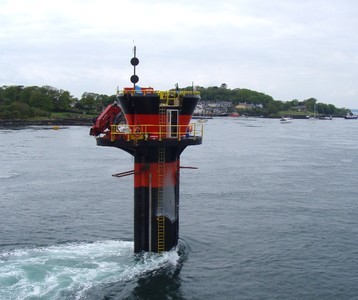5. Tides and Tidal Currents
The wind and density driven currents we have covered in chapters 2 and 3 generally flow in the same direction all the time. The current strength may vary, perhaps with time of year, but currents such as the Gulf stream and the Kuroshio always flow in the same direction.
Where major currents change direction, it is usually just once or twice a year. In the Indian Ocean the North Equatorial Current reverses its direction in concert with the Indian Monsoon. From November to March, during the northeast monsoon, it flows westward, and during the rest of the year it flows eastward.
Tidal currents reverse once or twice a day.
The gravitational pull of the moon (and to a lesser extent, the sun) is responsible for the horizontal movement of water, the tidal currents. Accumulation of water at the coastline results in a vertical movement of water we refer to as the tide. The greater the height difference between high and low tides, the faster the tidal current.
Tidal currents can reach speeds of greater than 2 m s-1 for example in China, in the Laotieshan Channel the maximum tidal current is up to 2.5 m s-1. The maximum tidal currents off the coast of Portugal are of the order of 0.2 to 0.5 m s-1. In the Bay of Fundy, between the Canadian provinces of New Brunswick and Nova Scotia, the tidal currents can reach 4 m s-1.
Why are tidal currents important?
Tidal currents affect us more than you might think. Tidal range - the difference between low and high tide - and the speed of the current can affect
- Shipping - entering/leaving harbours, coastal areas, estuaries
- coastal fishing - shellfish, fish farms, intertidal fishing, collecting
- tourism - size of beach area, safety
- pollution - tidal currents can break up some pollutants or carry others back to shore
- coastal erosion
- tidal energy - the regular reversal of the tidal currents can give a reliable supply of energy - for example the tidal power station at La Rance in France which uses a barrage, or more recent stand-alone systems off the coast of Dorset and at the European Marine Energy Centre (EMEC) off Orkney, Scotland


Source: Graham Bloomfield
When strong tides are funnelled into narrow channels they form a bore - a low 'wall' of water, which moves rapidly up the estuary. The Severn Bore is a good example of this.
Tides are important for mixing in ocean. As they flow through straits and across sills they create turbulence, which mixes surface and deep water together.
Source:Shuttle views of the earth: oceans from space
